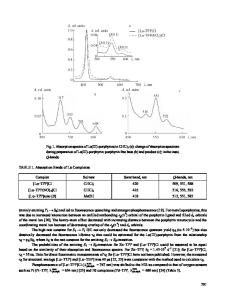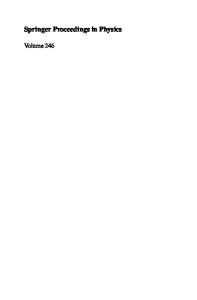The Lewis acidities of gold(I) and gold(III) derivatives: a theoretical study of complexes of AuCl and AuCl 3
- PDF / 848,917 Bytes
- 10 Pages / 595.276 x 790.866 pts Page_size
- 6 Downloads / 306 Views
ORIGINAL RESEARCH
The Lewis acidities of gold(I) and gold(III) derivatives: a theoretical study of complexes of AuCl and AuCl3 Cristina Trujillo 1 & Goar Sánchez-Sanz 2 & José Elguero 3 & Ibon Alkorta 3 Received: 16 June 2020 / Accepted: 6 July 2020 # Springer Science+Business Media, LLC, part of Springer Nature 2020
Abstract Chloride complexes of gold(I) (seventeen) and gold(III) (seventeen) with different ligands (including H, C, N, O, P, S as interacting atoms) have been studied at the CCSD(T)/CBS level. The computed geometries were compared with those found in the Cambridge Structural Database and the dissociation energies related with those previously reported in the literature by Yamamoto et al. Some special processes catalysed by these gold complexes such as bond-breaking (dihydrogen, cyclopropane) and arenes reactivity were studied in detail. Keywords Lewis acids . Sigma hole . CSD . Gold complexes
Introduction The importance of gold in cancer [1–5], nanotechnology [6] and nanoparticle research [1, 7, 8] and as catalyst has resulted in many original articles, reviews [9–19] and books [20–22]. The effect of the gold’s oxidation degree, i.e. Au(I) vs. Au(III), in its reactivity is also well known although the underlying reasons are still open to debate [23]. In this article, we study the ability of AuCl and AuCl3 to form complexes with a large variety of simple ligands, hydrogen, carbon, oxygen, nitrogen, phosphorus and sulphur derivatives (complexes 1a,b to 17a,b, Fig. 1) in order to better
Electronic supplementary material The online version of this article (https://doi.org/10.1007/s11224-020-01590-0) contains supplementary material, which is available to authorized users. * Goar Sánchez-Sanz [email protected] * Ibon Alkorta [email protected] 1
School of Chemistry, Trinity Biomedical Sciences Institute, Trinity College, Dublin, 152-160 Pearse St., Dublin 2, Ireland
2
Irish Centre of High-End Computing, Grand Canal Quay, Dublin 2, Ireland & School of Chemistry, University College Dublin, Belfield, Dublin 4, Ireland
3
Instituto de Química Médica,, CSIC, Juan de la Cierva, 3, 28006 Madrid, Spain
understand the effect of the oxidation degree on the reactivity of Au(I) and Au(III). Regarding their structures, it is known that in the solid state, AuCl forms chains resulting in a rock salt structure [24–26] while AuCl3 forms a dimer (Au2Cl6) [27]. Using electron diffraction, M. Hargittai et al. established that in the gas phase, AuCl is present as a monomer (C∞v), but AuCl3 continues being a dimer (D2h) [28]. The same conclusion was reached simultaneously by microwave rotational spectroscopy for AuCl [29]. Searching the Cambridge Structural Database (CSD) (compounds containing carbon atoms) [30, 31] and the ICSD (inorganic compounds) [32], we found that in gas phase using microwave spectroscopy (MW), the structures of complexes 1a [33] and 7a [34] (Fig. 1) had been determined. Additionally, Legon et al. had determined the structure of compounds I–Au···C2H2 (related to 5a in this work) [35] and I–Au···
Data Loading...











